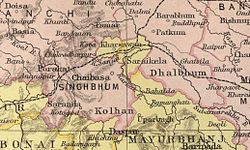Singhbhum district
| Singhbhum District | |||||
| District of the Bengal Presidency | |||||
|
|||||
|
Flag |
|||||
| Singhbhum district in a 1909 map of The Imperial Gazetteer of India | |||||
| Capital | Chaibasa | ||||
| History | |||||
| • | The Raja of Singhbhum becomes a feudatory of the British | 1820 | |||
| • | Post-independence Singhbhum District | 1947 | |||
| Area | |||||
| • | 1901 | 10,078 km2(3,891 sq mi) | |||
| Population | |||||
| • | 1901 | 613,579 | |||
| Density | 60.9 /km2 (157.7 /sq mi) | ||||
Flag
Singhbhum was a district of India during the British Raj, part of the Chota Nagpur Division of the Bengal Presidency. It was located in the present-day Indian state of Jharkhand. Chaibasa was the district headquarters. Located in the southern limit of the Chhota Nagpur Plateau, Singhbhum included the Kolhan estate located in its southeastern part. The district has been divided into three smaller districts, being East Singhbhum, West Singhbhum and Saraikela Kharsawan all are present in Jharkhand state of India.
It bounded with Ranchi District in the north, with the Saraikela and Kharsawan princely states in the east, with Mayurbhanj and Keonjhar in the south as well as with Bonai and Gangpur in the southwest. Singhbhum District had an area of 10,078 square kilometres (3,891 sq mi) and a population of 613,579 in 1901.
The Singhbhum area(bengali:সিংভূম) was never invaded by either the Marathas or the Mughals. The first relationships between the Raja of Singhbhum and the British were established in 1767 when he approached the Resident at Midnapore requesting protection. In 1820 the Raja became a feudatory of the British. The state was under the political control of the Commissioner of the Bengal Presidency until 1912, under the Bihar and Orissa Province until 1936 and then under Chhota Nagpur Division until the end of the British Raj.
...
Wikipedia


